Part of a series of articles titled Park Paleontology News - Vol. 10, No. 1, Spring 2018.
Article
The Paleontological Resources of National Capital Parks East

for Park Paleontology Newsletter, Spring 2018
National Capital Parks-East (NACE) was established in 1965. NACE consists of about 16 parks and sites between Washington DC and parts of Maryland. The parks range from natural resource parks, to historical sites, to recreational areas. About half of the parks at NACE are known to have fossil resources and fossils in the museum collection.
Most of the fossils were surfaced collected by Resource Management staff working on various projects in the field, but some were collected by everyone from Park Rangers to contract workers to visitors. Several paleontological surveys have been done with staff and interns from the Geological Resources Division, with the last one done in the summer of 2017.
Most of the fossils were surfaced collected by Resource Management staff working on various projects in the field, but some were collected by everyone from Park Rangers to contract workers to visitors. Several paleontological surveys have been done with staff and interns from the Geological Resources Division, with the last one done in the summer of 2017.
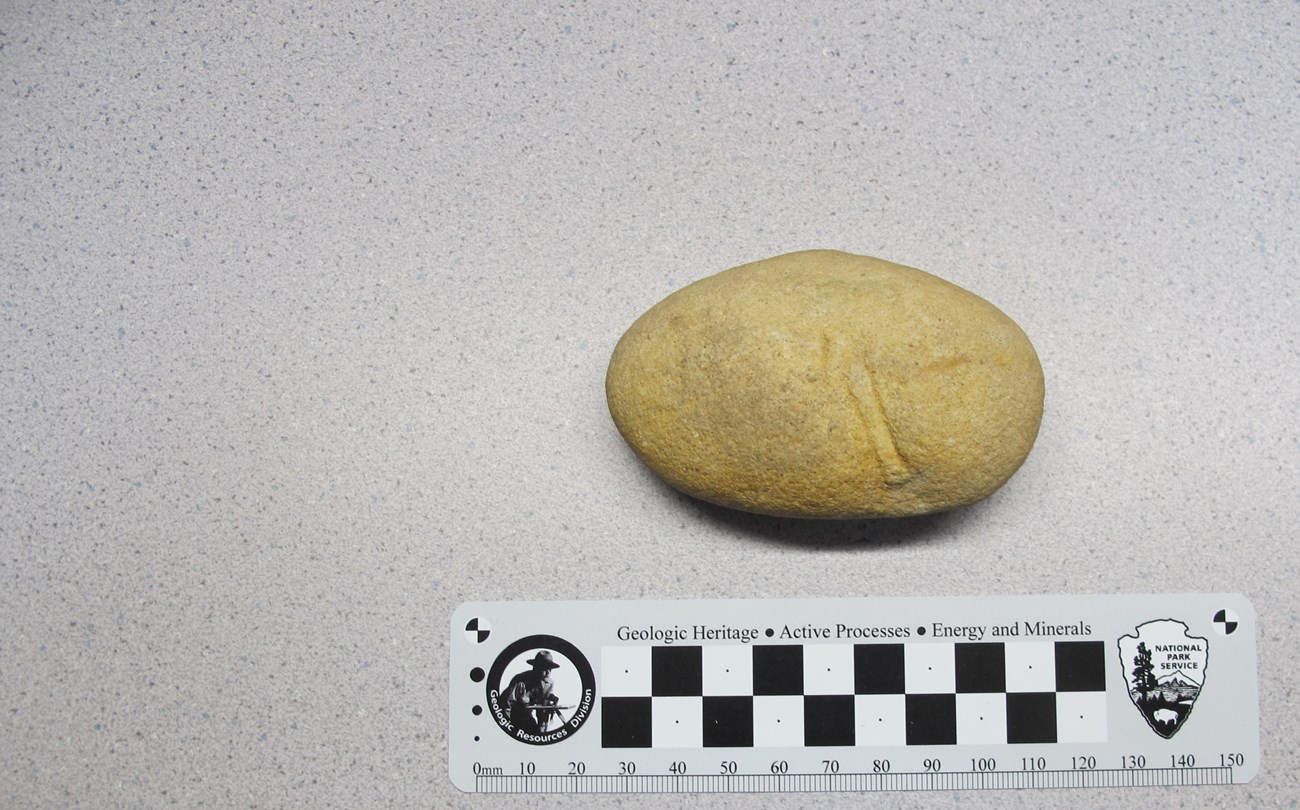
NPS Photo
Anacostia Park is located along the Anacostia River, and is where the headquarters of National Capital Parks-East is today. Most of the area has Quaternary alluvium and artificial fill. Only one fossil is in the collection, a quartzite cobble with tube burrows made by worms called Skolithos linearis. The specimen was collected by the park curator on June 6, 2013 while assisting the park biologist counting geese. The specimen likely was transported from the western part of Maryland down to the DC area by the Potomac and Anacostia rivers. The fossil dates to the early Cambrian, about 530 million years old.
Fort Circle Parks
NACE oversees several earth work forts that were constructed during the Civil War to protect Washington DC from rebel attacks. The Fort Circle Parks collection has one sandstone piece with the impression of a pelecypod shell. The specimen was collected on top of the Fort Dupont earth work by Park Ranger Wesley Gant in January 6, 2011. Most of Fort Dupont is in the Calvert Formation. The park also has older formations from the Potomac Group. But the fossil cannot be tied to any formation at this point.
Fort Washington Park
Most of the park is situated over the Aquia Formation. The Severn Formation and Patapsco Formation are also found in the park. The majority of the fossils in the collection were collected from the Aquia Formation. Three paleo surveys have been done at the park, in 2009, 2015 and 2016. The surveys were in ravine areas where fossils are found. Other areas surveyed have been along the Potomac Shoreline. Invertebrate fossils in the museum collection consist of Ostrea oysters, Cucullaea gigantea clam molds, and molds of the marine snail Kapalmerella mortoni. Vertebrate fossils consist of shark teeth from a mako species, other small shark teeth from a sand shark species, tooth plates from the cownose ray Rhinoptera sp., a scute from the sea turtle Catapleura ruhoffi, and an upper leg bone from an unidentified crocodile. The fossils date to about 55 million years ago. All of the invertebrates were affected by the Paleocene–Eocene Thermal Maximum extinction event.
Frederick Douglass National Historic Site
The last home of Frederick Douglass is on a hill on top of Pleistocene river deposits. No fossils of this age have been found here yet. However, there is an older fossil in the collection. A piece of quartzite with a Skolithos tube burrow was found on the steps leading to the house on November 19, 2012 by the author as maintenance was cleaning out the flower beds nearby. The fossil was probably found in the flower bed and was transported to the area by an ancestral Potomac River millions of years ago. Soft-bodied animals such as worms made the tube burrows.
Frederick Douglass was also known to collect natural history specimens such as shells, plants, rocks, and coral.
There are at least two coral specimens that could be fossils and are being researched now. There is a book on fossil oysters in the collection. The book is called “A review of the Fossil Ostreidae of North America and a comparison of the fossil with the living forms”, by Charles A. White, MD. Dr. White had sent a copy of his book to Mr. Douglass with an inscription to him on the front cover. Dr. White had also done paleonotological work in the early days of national parks such as Yellowstone National Park, Grand Canyon National Park, and Dinosaur National Monument.
The last home of Frederick Douglass is on a hill on top of Pleistocene river deposits. No fossils of this age have been found here yet. However, there is an older fossil in the collection. A piece of quartzite with a Skolithos tube burrow was found on the steps leading to the house on November 19, 2012 by the author as maintenance was cleaning out the flower beds nearby. The fossil was probably found in the flower bed and was transported to the area by an ancestral Potomac River millions of years ago. Soft-bodied animals such as worms made the tube burrows.
Frederick Douglass was also known to collect natural history specimens such as shells, plants, rocks, and coral.
There are at least two coral specimens that could be fossils and are being researched now. There is a book on fossil oysters in the collection. The book is called “A review of the Fossil Ostreidae of North America and a comparison of the fossil with the living forms”, by Charles A. White, MD. Dr. White had sent a copy of his book to Mr. Douglass with an inscription to him on the front cover. Dr. White had also done paleonotological work in the early days of national parks such as Yellowstone National Park, Grand Canyon National Park, and Dinosaur National Monument.
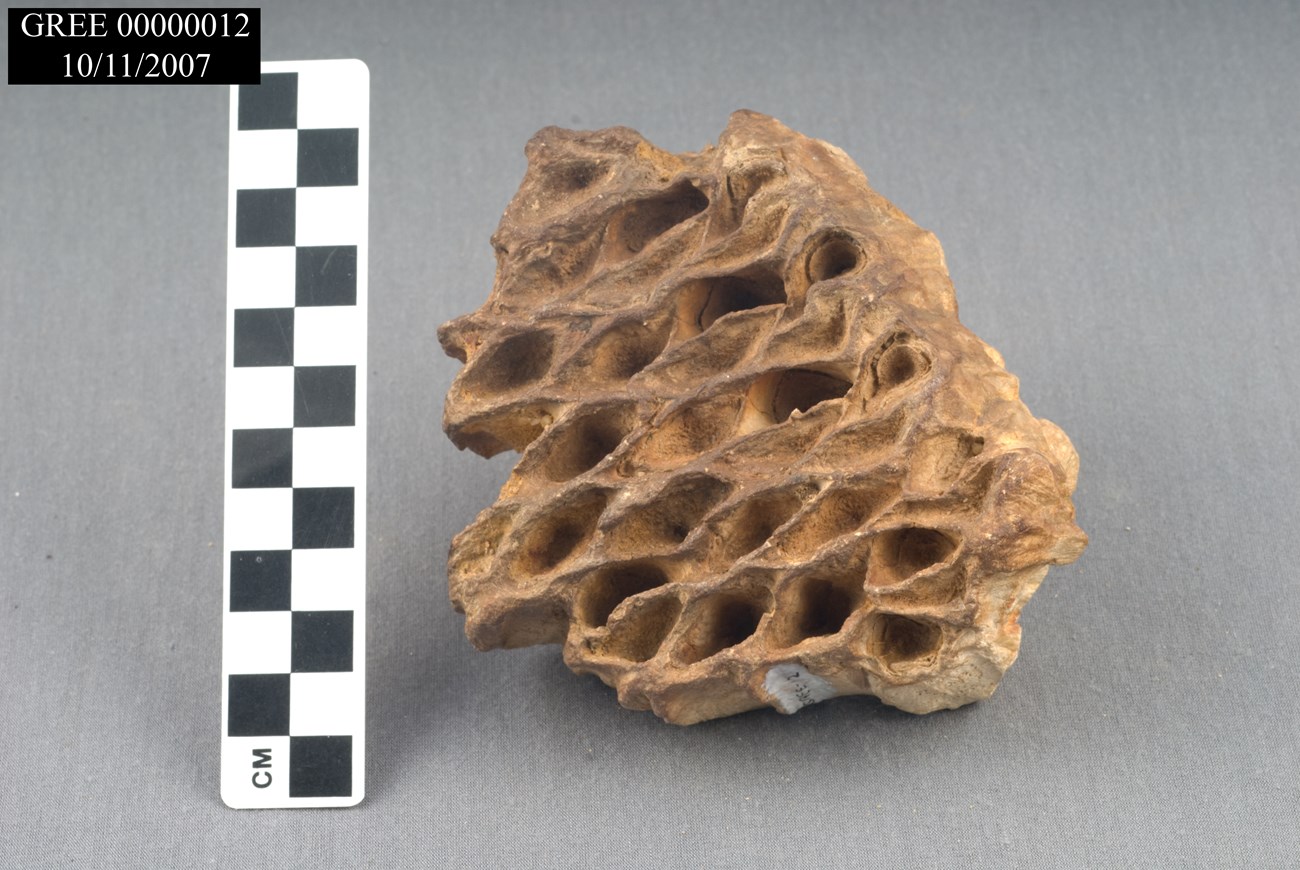
NPS Photo
The Potomac Group underlies most of the park. There is one plant fossil in the collection from this formation. It is a cycadeoid (Cycadeoidea marylandica). The fossil is part of the bark of a tree that fossilized. It is a rare find and was found in 1970 during a biological survey in the park by Leo Hickey and ecologist Kaye Thomas. On July 15, 2014, a paleo survey was conducted along an area of Still Creek by Mike Antonioni and Justin Tweet, paleontologist for the Geological Resources Division. The reason for the survey was a visitor had told a ranger about plant fossils she had seen in the area. She also turned in a specimen she thought was from a plant fossil, but it turned out to be a piece of sandstone instead. No plant fossils were found. However, a small piece of quartzite was collected by the author because it had a tube burrow from Skolithos linearis, probably transported by water from western part of the state.
Oxon Cove Park
The Potomac Group is the oldest formation in this park. A recent survey of the park was done in May 2017 by a GIP Intern, Margot D. Nelson. Upland deposits are found in hills of the park that date to the Miocene–Pliocene. While no fossils were found from this formation, the park was recommended to monitor the ravines for any fossils that may become exposed from erosion. Only two fossils are in the collection. Both are trace fossils called Skolithos linearis. These trace fossils are tube burrows made by a worm or worm like animal. These traces date to the early Cambrian and were transported from an ancestral Potomac River millions of years ago.
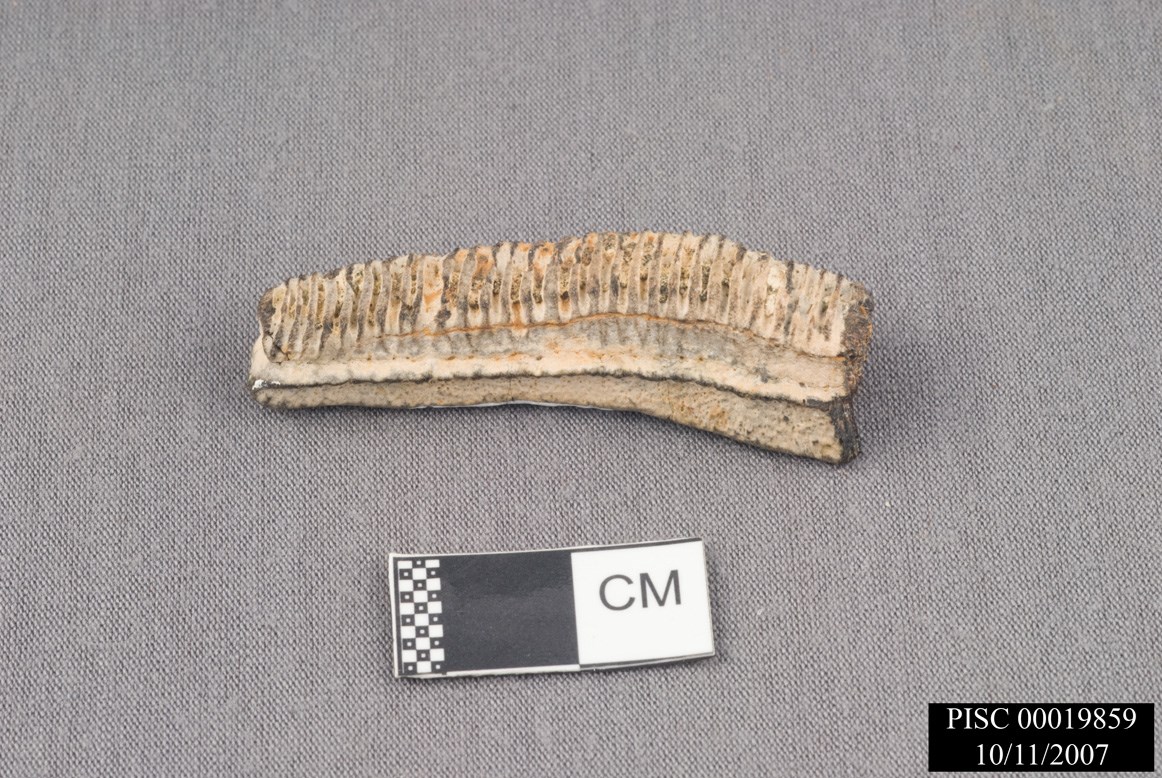
NPS Photo
The Aquia Formation is the main formation in this park. Like Fort Washington Park, Piscataway Park also has older formations such as the Patapsco Formation. Most of the fossils in the museum collection are marine invertebrates from the Aquia Formation. Some of the invertebrates are oyster shells from the genus Ostrea, gastropods from the genus Kapalmerella mortoni, and clam molds from Cucullaea gigantea. The only vertebrate fossils found are cow nose ray plates from the genus Rhinoptera. All fossils have been found by staff doing biological surveys. So far there have been no paleo surveys in this park yet.
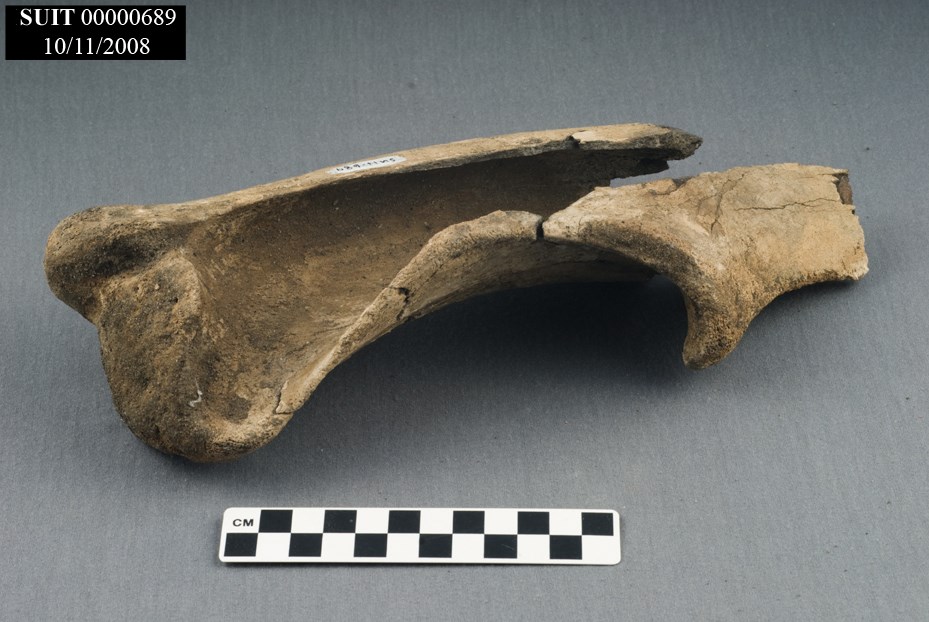
NPS Photo
The Calvert Formation is the main formation in this park. In 1997, several fossils were found during construction of the Green Line metro subway. The fossils were sent to the Smithsonian, but later returned to the park after it was discovered that the fossils still belonged to the NPS at the time they were discovered. The fossils found were parts of a jaw and skull of a baleen whale, a rib bone from a dugong of the genus Metaxytherium, and two shark teeth from Hemipristis serra and Isurus hastalis. Three bones from land animals were also found in the same area: A rib bone from a peccary and two bones from unknown predators. The whale skull was put together by fossil predator Fred Grady at the Smithsonian on September 17, 2004. Some of the sand was taken from the skull and sent to Dr. Lucy Edwards of the USGS to get a date of the specimen. The results were early to middle Miocene period, about 16 million years old. The sample was assigned to Zone DN4 which is restricted to the Plum Point member of the Calvert formation.
Dave Bohaska, Paleontologist at the Smithsonian commented that the material was significant because marine mammal fossils are rarely found in the Calvert Formation outside of the Calvert Cliffs area. Larry Barnes, Curator of the Los Angles Museum of Natural History, commented that the specimen could be a rarer specimen or even a new species of baleen whale.
Photos from the specimen were sent to Dr. Robert Boessenecker, College of Charleston Department of Geology and Environmental Geosciences. According to Dr. Boessenecker the skull is similar to Diorocetus and Parietobalaena. More research is needed on this specimen.
SUIT also has sediments of the late Paleocene-aged Aquia Formation of the Paleocene-Eocene Pamunkey Group. Exposures are found along Henson Creek banks. The only fossil from this formation found during the work on the subway was a right valve from Ostrea sinuosa.
A Skolithos linearis fossil burrow was collected during a paleo survey in the spring of 2016. The survey was to look for fossils formations before a sewer pipe could be put in
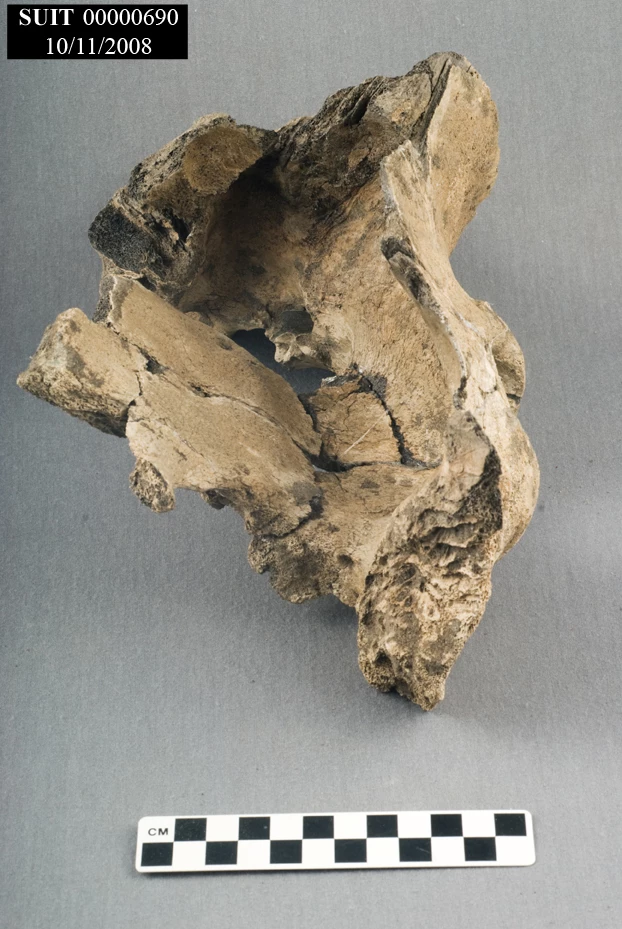
NPS Photo
Last updated: April 23, 2020
